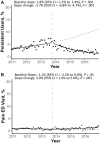Impacts of an Opioid Safety Initiative on US Veterans Undergoing Cancer Treatment
- PMID: 35078240
- PMCID: PMC9086780
- DOI: 10.1093/jnci/djac017
Impacts of an Opioid Safety Initiative on US Veterans Undergoing Cancer Treatment
Abstract
Background: There is limited research on how the opioid epidemic and consequent risk reduction policies have affected pain management among cancer patients. The purpose of this study was to analyze how the Opioid Safety Initiative (OSI) implemented at the Veterans Health Administration affected opioid prescribing patterns and opioid-related toxicity.
Methods: We performed an interrupted time series analysis of 42 064 opioid-naïve patients treated at the Veterans Health Administration for prostate, lung, breast, and colorectal cancer from 2011 to 2016. Segmented regression was used to evaluate the impact of the OSI on the incidence of any new opioid prescriptions, high-risk prescriptions, persistent use, and pain-related emergency department (ED) visits. We compared the cumulative incidence of adverse opioid events including an opioid-related admission or diagnosis of misuse before and after the OSI. All statistical tests were 2-sided.
Results: The incidence of new opioid prescriptions was 26.7% (95% confidence interval [CI] = 25.0% to 28.4%) in 2011 and increased to 50.6% (95% CI = 48.3% to 53.0%) by 2013 before OSI implementation (monthly rate of change: +3.3%, 95% CI = 1.3% to 4.2%, P < .001). After the OSI, there was a decrease in the monthly rate of change for new prescriptions (-3.4%, 95% CI = -3.9 to -2.9%, P < .001). The implementation of the OSI was associated with a decrease in the monthly rate of change of concomitant benzodiazepines and opioid prescriptions (-2.5%, 95% CI = -3.2% to -1.8%, P < .001), no statistically significant change in high-dose opioids (-1.2%, 95% CI = -3.2% to 0.9%, P = .26), a decrease in persistent opioid use (-5.7%, 95% CI = -6.8% to -4.7%, P < .001), and an increase in pain-related ED visits (+3.0%, 95% CI = 1.0% to 5.0%, P = .003). The OSI was associated with a decreased incidence of opioid-related admissions (3-year cumulative incidence: 0.9% [95% CI = 0.7% to 1.0%] vs 0.5% [95% CI = 0.4% to 0.6%], P < .001) and no statistically significant change in the incidence of opioid misuse (3-year cumulative incidence: 1.2% [95% CI = 1.0% to 1.3%] vs 1.2% [95% CI = 1.1% to 1.4%], P = .77).
Conclusions: The OSI was associated with a relative decline in the rate of new, persistent, and certain high-risk opioid prescribing as well as a slight increase in the rate of pain-related ED visits. Further research on patient-centered outcomes is required to optimize opioid prescribing policies for patients with cancer.
© The Author(s) 2022. Published by Oxford University Press. All rights reserved. For permissions, please email: journals.permissions@oup.com.
Figures





References
-
- Hedegaard H, Minino AM, Warner M. Drug overdose deaths in the United States, 1999-2018. 2020. https://www.cdc.gov/nchs/data/databriefs/db356-h.pdf. Accessed March 1, 2021. - PubMed

